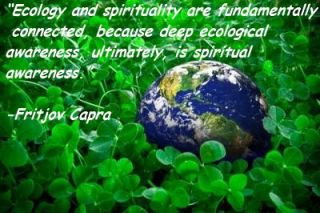Environment
Deep Ecology and Evolution of Consciousness: Part 4 of 5
What would an enlightened society look like? Can human consciousness evolve?
Posted August 8, 2013
Since the consciousness revolution of the 1960s and the back-to-the-land movement of the 1970s, many people have followed a path outside the mainstream of the industrial growth society. Laws have been passed to protect the environment, and civil rights advances have been made. Slowly organic farming became established and is now certified by national standards. Demand for organic food and sustainable products is growing rapidly. Even so, these movements remain largely marginalized.
In the United States and throughout the industrialized world, those in power seek to use the current energy crisis as a justification to greatly increase the number of nuclear power plants and to extract destructive products such as tar sands, at the same time as more enlightened efforts move forward to develop alternative energy sources based on wind, solar, and biomass. In China, India, Chile, and other developing countries, those in power continue to dam large rivers, displacing millions of people, destroying cultural artifacts, and devastating the environment. Even though the destructiveness of large hydroelectric projects is evident in the United States and other countries, the hunger for energy to fuel the industrial growth society and the lust for wealth seem to overshadow the lessons that could be learned from the mistakes of others.
In these times, it seems we are on the verge of making a breakthrough in consciousness characterized by the sixth chakra and honoring the fourth chakra. This consciousness would heal the mind-body, human-nature, and matter-spirit splits. This is the consciousness of deep ecology, which views everything as alive, humans as part of the web of life, and all life as sacred.

Deep Ecology and Spiritual Awareness
The tenets of deep ecology value peace and social justice, as well as plants, animals, and ecosystems. In this worldview, relationships and communities based on love and caring are more valuable than material wealth and power. Healthy, intact ecosystems, including healthy people, are valued more than resource extraction and labor exploitation.
Meaning and purpose would be valued more than accumulation of money. Money would be seen as a means to create and maintain life-sustaining systems. These would include educational systems that nurture all aspects of the growing person, and economic systems where everyone worked enough to keep the system functioning and had enough leisure time for recreation and development of human potential. This would be in contrast to the current system where most people don’t have enough of a livelihood to sustain their basic needs, a few people control the majority of the wealth, and the rest work more than 40 hours a week to maintain an unsustainable quality of life based on the values of the industrial growth society.
In the sixth chakra civilization, with the fourth chakra heart opening, humans’ connection to the rest of the planet would be experienced, known, and acknowledged by the majority of people. Destruction of old growth forests, rain forests, and other ecosystems would be a thing of the past. The rate of human population growth would continue to decline until the actual number of humans was at a sustainable level. This would be brought about by raising the standard of living: access to health care, birth control, education, and self-determination for all people. Could this vision be realized?


